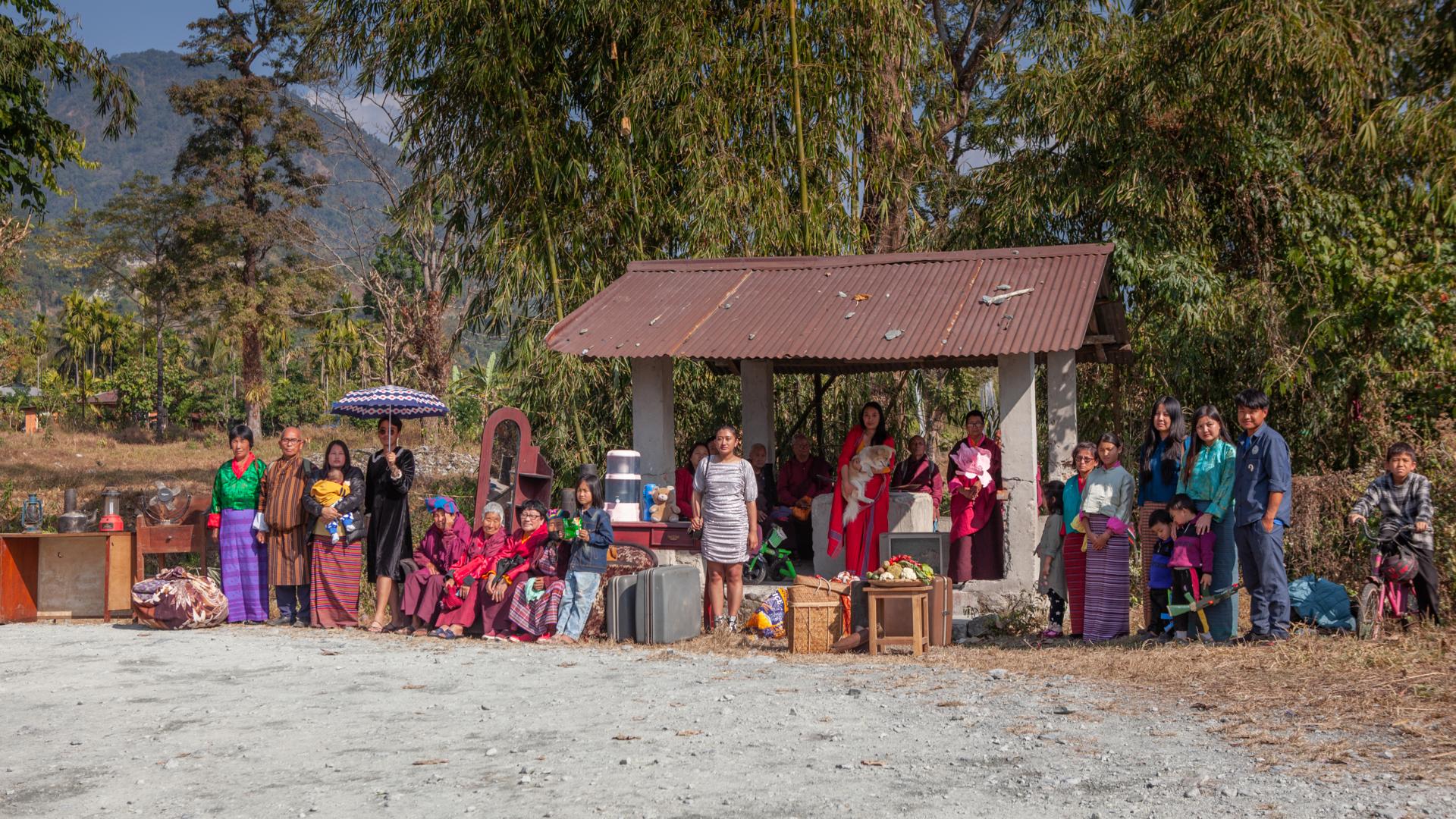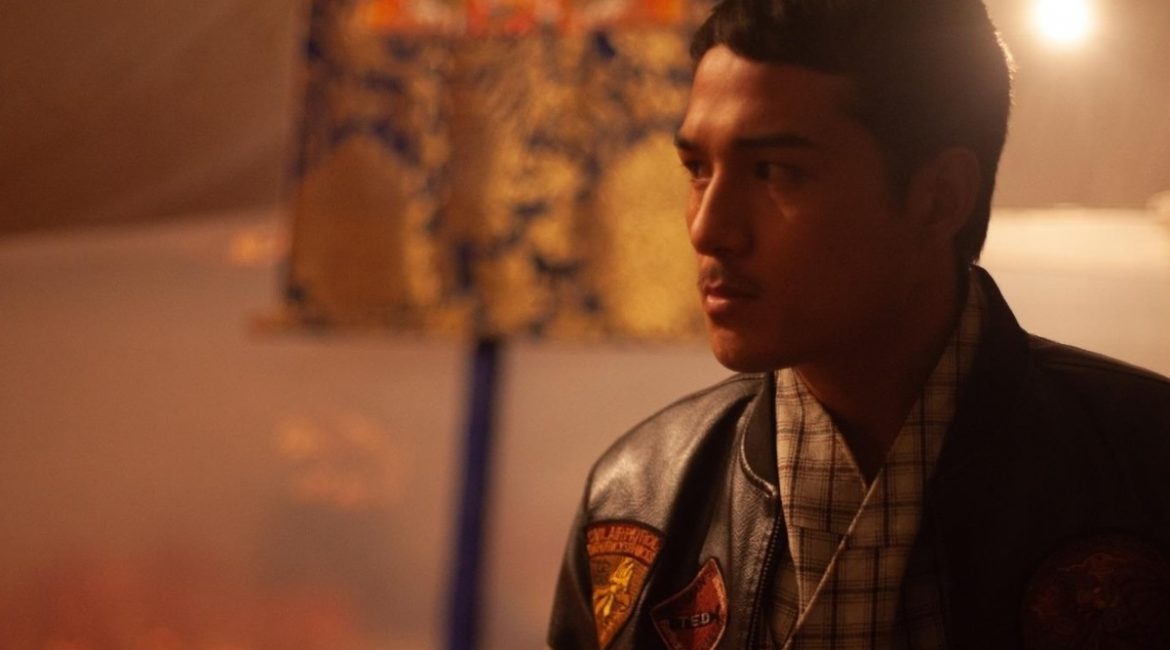Alana Siegel is a poet living in Upstate New York. Her full-length collection of poetry, Archipelago, is published by Station Hill Press. In 2019, she completed a Three Year Retreat at Pema Osel Ling. In 2023, she received a NYSCA Rural and Traditional Arts grant to write, direct and act in Persephone’s Dream, a 12 hour play and meditation weaving together agricultural and theatrical practices drawn from Noh Theater, The Patrons of the Orders of Husbandry, and the Eleusinian Mysteries. Beginning this fall, for the Creative Resilience project through the Khyentse Foundation, she is teaching a poetry workshop centered around Sky and Speech.
Khyentse Norbu’s Pig At the Crossing, is a film you want to watch again immediately after seeing it. Watching this film was an exercise in overcoming obstacles, not only in my own experience, but reported from multiple friends. Two friends couldn’t figure out how to turn on subtitles, so they watched the film without any dialogue in their mother tongue. Another friend was looking after his elderly mother while she was watching blaring television and he told her he was going to watch this film, but would be right next to her if she needed anything. He placed his headphones on his ears as he tried to focus on the film while the neon glow of his mother’s television was lit behind his screen in her bedroom. I was staying at a relative’s apartment in New York City, and was running to get back in time to watch this initial screening, racing through the rainy city to make sure I didn’t miss this moment.
Our various approaches, and thresholds from which to watch Pig At the Crossing felt like their own kinds of birth, or rebirth, into and from realms unfamiliar to us. My friends watched without the known foreground of the English language. My other friend was set against the wallpaper of his mother’s bedroom and his care for her, as a kind of birth passage. I wasn’t in my own home, but the home of blood relatives, the night before I would fly home to California, the place of my birth. We, and I imagine many others, were held on the edge of a precipice, of what we know, and what we do not know at all, when watching this.
This film went deeply into the experience of knowing, not knowing, being known, not being known—whether it is by not being heard, or seen, or through any of the other sense doors we have become accustomed to. When the protagonist, Dolom, has died, and has not yet realized he has died, he speaks to people he loves and knows, but they fail to hear him. I thought of moments in life when you are speaking to someone and they do not hear you, though both of you are alive. And by “not hearing” I mean sheerly not hearing, but also not understanding. This film illuminates how we might be more used to the afterlife experience, or the in-between realm of the bardo, than we think. Each moment a loved one does not hear us, is this a drop, a brush with this deeper realm of not hearing, not being heard?
The film opens over the deep and long, extended foreground that almost never dissolves into a background, remaining an endless horizon extending towards the viewer, of a market, a commonplace of fruits and vegetables and conversation. The film opens without seeing the people who are talking. After a considerable beat, the people enter. This trope takes place multiple times in the film—frames without people—landscapes bereft of humans, of subjects. Or, the people in the scene are pushed to the far left or the far right of the frame. This communicated to me, the viewer, a sense of selflessness, a feeling of “life goes on without me, without this character.” I experienced a palpable, visual privileging of, an accentuated proportional communication of the relationship between the person in the frame and the totality of the frame, between one life, and all life, which felt acutely philosophical, ontological. What more was being said by this gesture?

Out of all of Khyentse Norbu’s films, the dynamism and confidence in cinematography as a language, not only instilled confidence in the interpretive capacity of the viewer, but in the mastery of the vehicles of communication activated. In the extended, expanded, slowed down sequences in which Dolom is following his guide, however reluctantly, I saw overtones of the films of Tarkovsky, most notably, “Stalker.” When the tomato dropped on the ground after Dolom’s bike accident, the lushness of the red, and the slowness yet punctuation of its fall, reminded me of films of Wong Kar Wai, primarily, “In the Mood for Love,” in which the choice is made to show an object, or an action, adjacent, next to the story being told, oblique to what is happening. Rather than “showing what is happening,” showing Dolom on his motorcycle colliding with a car, and the blood, and the gore, we are shown a tomato falling and hitting the ground. The choice to “not show,” or “show something else,” choosing a visual action over spoken dialogue, sets the film on another plane of absorption, another ground of relation between subject and object. When Dolom walks up to the prayer flags he was supposed to meet Deki at before he dies, and is now dead, gazing at the prayer flags swaying in the wind—a tone from Kurosawa’s Dreams rose to the surface. The prayer flags swaying in the wind could have been seen as a “normal” sight, but the way in which the camera remained on them for just a little longer than usual, imbued and synchronized their swaying in the wind, with the swaying of Dolom’s emotions—their ambiguity, simplicity, and yet, extraordinary quality.

In addition to undertones of notable film directors and cinematographers in the visual landscape, how directors communicate emotion to the viewer pays homage to the works of other filmmakers. When Dolom walks up to his own death ceremony, and a German woman begins singing operatically, or when the man in the nightclub bar, in which a glowing “Zarathustra” sign is perched above the door—when this man who is also dead, begins barking out of nowhere—these surreal, and heightened emotions without any explanation are emblematic of wild personae in the films of David Lynch. The reticence of expression, intensifying the states of inner emotions of characters signifying the impossible love and beauty and pain and difficulty of family relations, and relations between loved ones, the compression of pain inextricable from love, felt akin to Ozu and his gentle care for his characters.
But enough of other directors, and other films. This film stands on its own, imparting influence to a present moment, culturally, historically. Khyentse Norbu plays with and provokes our relationship to technology and one another. When Dolom is dead, he keeps reviewing his life through films he has captured on his phone. Don’t we do this all the time? Steeped in the business of memorializing, before anything even happens? Echoing what I alluded to earlier, I feel this film does not claim to capture “what it is like,” necessarily, in the state between lives, but turns the film back upon the living viewer. How much do you already undergo your non-existence? How much is your being already acquainted with the process of, and the moment of dying? And how much are you completely unprepared for anything like this? And how much could you, can you, prepare? I often think to myself, my love for my mom is also my fear of my mom dying. This could be held out to everyone I love, but naturally, I feel it most strongly with my mom. In a distilled, and intimate disclosure, Dolom’s guide, as he is trying to relay to him that he is dead, says, “Not a moment has passed since your death and the death of Christ.” By these lines, we are suspended, viewer and character, into a space outside of time. Is it possible to comprehend what the implications of his statement are?
A friend of mine said recently that she only really feels comfortable living in a place where people have lived many lives, for thousands of years. I asked her why, even though I instantly understood. There was something about feeling the bond of the human family—the human family, beyond the biological. I imagine timelessness is the site of this bond.

Last night was the second time watching Pig At the Crossing. I had signed up to watch it again, months before, the day I returned from California. I mixed up the times, and missed the viewing window. “That I missed the window,” another friend commented, was a teaching in itself. This time I wasn’t going to miss it. I was determined to spend my Saturday night at home studying it. The subtitles would not turn on when I projected the film onto a larger screen, so after much tinkering, I huddled in bed and watched on my small screen. The film was like a practice book I was kindling, not with candlelight, but with the glow that came directly from it—my eyes shifting from left to right to left, reading, silently reciting in the form of listening, watching. The main character keeps being encouraged, or more so ordered, by his guide, to cross. What is keeping him from crossing? It seems clear. Desire for people he loves, for the life he remembers. But is it? And what is he crossing—from where to where? From life to death, to life—but is that clear at all? This film reflexively embedded itself in me in the form of a teaching, more directly—an instruction—to cross.
In Vajrayana Buddhism there is a distinction between the sudden and gradual paths, the aspirational and resultant. Am I here already, or do I have to get there—here? Have I crossed? Could I? Am I? I desire to cross. Please let me cross. I have crossed. I thought of Beckett and the collapse of language which is also each moment of language liberating itself from itself, such as the end of Malone Dies, in which the lines are, “All is ready. Except me. I am being given, if I may venture the expression, birth to into death, such is my impression.” Nearing the end of the film, I misread Dolom say to his guide, “Is this the edit of me?” when what he really asked was, “Is this the end of me?” End, or edit—my misreading is a modification of relations—not a termination. A shifting of parts, of frames. And out of all possible predisposition, how is this the persona I have come to be?
This film performs the function of the process it’s portraying. I watch this film like I’m looking back upon it. I remember my life and look to the future like I’m making a film, or in the constant process of its edit. Seeing this film for the second time made me want to watch it for the third. I feel dependent upon it, in an essential way, for my organism, like I need air. I continue to feel I missed something. I have to go back to it. This film itself is a crossing, and I am grateful for it.


